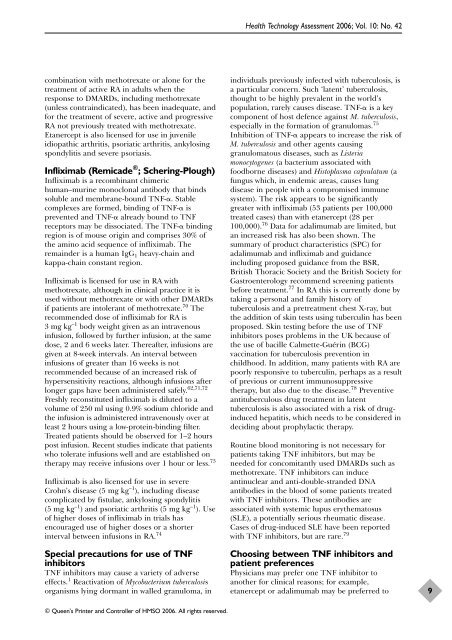A systematic review of the effectiveness of adalimumab
A systematic review of the effectiveness of adalimumab
A systematic review of the effectiveness of adalimumab
Create successful ePaper yourself
Turn your PDF publications into a flip-book with our unique Google optimized e-Paper software.
combination with methotrexate or alone for <strong>the</strong><br />
treatment <strong>of</strong> active RA in adults when <strong>the</strong><br />
response to DMARDs, including methotrexate<br />
(unless contraindicated), has been inadequate, and<br />
for <strong>the</strong> treatment <strong>of</strong> severe, active and progressive<br />
RA not previously treated with methotrexate.<br />
Etanercept is also licensed for use in juvenile<br />
idiopathic arthritis, psoriatic arthritis, ankylosing<br />
spondylitis and severe psoriasis.<br />
Infliximab (Remicade ® ; Schering-Plough)<br />
Infliximab is a recombinant chimeric<br />
human–murine monoclonal antibody that binds<br />
soluble and membrane-bound TNF-. Stable<br />
complexes are formed, binding <strong>of</strong> TNF- is<br />
prevented and TNF- already bound to TNF<br />
receptors may be dissociated. The TNF- binding<br />
region is <strong>of</strong> mouse origin and comprises 30% <strong>of</strong><br />
<strong>the</strong> amino acid sequence <strong>of</strong> infliximab. The<br />
remainder is a human IgG 1 heavy-chain and<br />
kappa-chain constant region.<br />
Infliximab is licensed for use in RA with<br />
methotrexate, although in clinical practice it is<br />
used without methotrexate or with o<strong>the</strong>r DMARDs<br />
if patients are intolerant <strong>of</strong> methotrexate. 70 The<br />
recommended dose <strong>of</strong> infliximab for RA is<br />
3mgkg –1 body weight given as an intravenous<br />
infusion, followed by fur<strong>the</strong>r infusion, at <strong>the</strong> same<br />
dose, 2 and 6 weeks later. Thereafter, infusions are<br />
given at 8-week intervals. An interval between<br />
infusions <strong>of</strong> greater than 16 weeks is not<br />
recommended because <strong>of</strong> an increased risk <strong>of</strong><br />
hypersensitivity reactions, although infusions after<br />
longer gaps have been administered safely. 62,71,72<br />
Freshly reconstituted infliximab is diluted to a<br />
volume <strong>of</strong> 250 ml using 0.9% sodium chloride and<br />
<strong>the</strong> infusion is administered intravenously over at<br />
least 2 hours using a low-protein-binding filter.<br />
Treated patients should be observed for 1–2 hours<br />
post infusion. Recent studies indicate that patients<br />
who tolerate infusions well and are established on<br />
<strong>the</strong>rapy may receive infusions over 1 hour or less. 73<br />
Infliximab is also licensed for use in severe<br />
Crohn’s disease (5 mg kg –1 ), including disease<br />
complicated by fistulae, ankylosing spondylitis<br />
(5 mg kg –1 ) and psoriatic arthritis (5 mg kg –1 ). Use<br />
<strong>of</strong> higher doses <strong>of</strong> infliximab in trials has<br />
encouraged use <strong>of</strong> higher doses or a shorter<br />
interval between infusions in RA. 74<br />
Special precautions for use <strong>of</strong> TNF<br />
inhibitors<br />
TNF inhibitors may cause a variety <strong>of</strong> adverse<br />
effects. 1 Reactivation <strong>of</strong> Mycobacterium tuberculosis<br />
organisms lying dormant in walled granuloma, in<br />
© Queen’s Printer and Controller <strong>of</strong> HMSO 2006. All rights reserved.<br />
Health Technology Assessment 2006; Vol. 10: No. 42<br />
individuals previously infected with tuberculosis, is<br />
a particular concern. Such ‘latent’ tuberculosis,<br />
thought to be highly prevalent in <strong>the</strong> world’s<br />
population, rarely causes disease. TNF- is a key<br />
component <strong>of</strong> host defence against M. tuberculosis,<br />
especially in <strong>the</strong> formation <strong>of</strong> granulomas. 75<br />
Inhibition <strong>of</strong> TNF- appears to increase <strong>the</strong> risk <strong>of</strong><br />
M. tuberculosis and o<strong>the</strong>r agents causing<br />
granulomatous diseases, such as Listeria<br />
monocytogenes (a bacterium associated with<br />
foodborne diseases) and Histoplasma capsulatum (a<br />
fungus which, in endemic areas, causes lung<br />
disease in people with a compromised immune<br />
system). The risk appears to be significantly<br />
greater with infliximab (53 patients per 100,000<br />
treated cases) than with etanercept (28 per<br />
100,000). 76 Data for <strong>adalimumab</strong> are limited, but<br />
an increased risk has also been shown. The<br />
summary <strong>of</strong> product characteristics (SPC) for<br />
<strong>adalimumab</strong> and infliximab and guidance<br />
including proposed guidance from <strong>the</strong> BSR,<br />
British Thoracic Society and <strong>the</strong> British Society for<br />
Gastroenterology recommend screening patients<br />
before treatment. 77 In RA this is currently done by<br />
taking a personal and family history <strong>of</strong><br />
tuberculosis and a pretreatment chest X-ray, but<br />
<strong>the</strong> addition <strong>of</strong> skin tests using tuberculin has been<br />
proposed. Skin testing before <strong>the</strong> use <strong>of</strong> TNF<br />
inhibitors poses problems in <strong>the</strong> UK because <strong>of</strong><br />
<strong>the</strong> use <strong>of</strong> bacille Calmette-Guérin (BCG)<br />
vaccination for tuberculosis prevention in<br />
childhood. In addition, many patients with RA are<br />
poorly responsive to tuberculin, perhaps as a result<br />
<strong>of</strong> previous or current immunosuppressive<br />
<strong>the</strong>rapy, but also due to <strong>the</strong> disease. 78 Preventive<br />
antituberculous drug treatment in latent<br />
tuberculosis is also associated with a risk <strong>of</strong> druginduced<br />
hepatitis, which needs to be considered in<br />
deciding about prophylactic <strong>the</strong>rapy.<br />
Routine blood monitoring is not necessary for<br />
patients taking TNF inhibitors, but may be<br />
needed for concomitantly used DMARDs such as<br />
methotrexate. TNF inhibitors can induce<br />
antinuclear and anti-double-stranded DNA<br />
antibodies in <strong>the</strong> blood <strong>of</strong> some patients treated<br />
with TNF inhibitors. These antibodies are<br />
associated with systemic lupus ery<strong>the</strong>matosus<br />
(SLE), a potentially serious rheumatic disease.<br />
Cases <strong>of</strong> drug-induced SLE have been reported<br />
with TNF inhibitors, but are rare. 79<br />
Choosing between TNF inhibitors and<br />
patient preferences<br />
Physicians may prefer one TNF inhibitor to<br />
ano<strong>the</strong>r for clinical reasons; for example,<br />
etanercept or <strong>adalimumab</strong> may be preferred to<br />
9
















